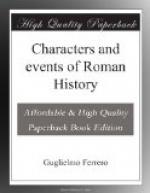It is clear, then, according to Pliny, at one time, it was believed that the competition of Gallic dyers might have ruined the Oriental, and would have done so, had the tenacity of their vegetable colouring equalled its beauty. In another passage Pliny tells us that these Gallic stuffs were used especially by the slaves and the populace.
The wool industry made no less progress in Gaul than weaving and dyeing. From numerous passages in Juvenal and Martial it appears that the woollen clothing worn by the populace of Rome in the second century was woven in Gaul, particularly in the districts to-day known as Arras, Langres, Saintonge. Pliny attributes to the Gauls the invention of a wool, that, soaked in acid, became incombustible, and was used to make mattresses.
Glass-making was another art carried from the East across the Mediterranean into Gaul. Still another industry, metallurgy, after weaving, contributed greatly to enrich Gaul. Undoubtedly even before the Roman conquest, Gaul worked gold mines; it seems, however, that silver mines remained untouched until about the time of Augustus. At any rate, the discovery of some deposits of gold and silver then gave a spur to several flourishing industries; jewelry-making, and—an original Gallic industry of much importance—silver-plating and tinning. Here is another extract from Pliny, from which you will see that in those times they already made in France “Christofle” silver-plate:
They cover [writes Pliny] the copper with tin in such a way that it is difficult to distinguish it from silver. It is a Gallic invention. Later they began to do the same thing with silver, silver-plating especially the ornaments of horses and carriages. The merit of the invention belongs to the Biturigi, and the industry was developed in the city of Alesia. After the same fashion there has been spread everywhere a foolish profusion of objects not only silver-, but gold-plated. All that is called cultus, elegance!
We might almost say that Gallic industry did to the old industries of the ancient world what German wares have done compared with older and more aristocratic products of France, of England, popularising objects of luxury for the many and the merely well-to-do.
Finally, if any one hesitated to trust fully these very important passages in Pliny, he would be quite convinced by reading the great work of Dechelette. This author, studying with Carthusian patience and the ablest critical acumen the Gallic ceramics to be found scattered among the museums, has demonstrated most commendably that in the first century of the Empire many manufactories of ceramics were opened and flourished in Gaul, especially in the valley of the Allier, and that they sold their vases in Spain, in the Danube regions, to the Germans, and in Italy.
Dechelette has proved that many ceramics found among the ruins of Pompeii, now admired in the museums of Pompeii and Naples, were made in Gaul,—discoveries most noteworthy, which, in connection with the extracts from Pliny, disclose in essence that real Roman Gaul whose sumptuous relics but half tell the tale of its wealth.




